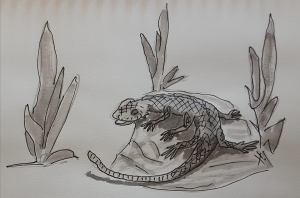Difference between revisions of "Wormtail"
From World of Entorais Wiki
Jump to navigationJump to searchm (→Description: spelling) |
m (Text replacement - "Sub-Species" to "Notable Sub-Species") |
||
| Line 21: | Line 21: | ||
;Reproduction:After mating females will lay a half dozen eggs in a shallow scraped nest, or den. She will brood the eggs until hatching. Young wormtails will stay near their parent for a few months until they are able to successfully hunt on their own. | ;Reproduction:After mating females will lay a half dozen eggs in a shallow scraped nest, or den. She will brood the eggs until hatching. Young wormtails will stay near their parent for a few months until they are able to successfully hunt on their own. | ||
;Hunting:Wormtails utilize the tips of their tails as bait. Laying in wait behind cover, they will wriggle their tail tips in a manner that resembles a worm wriggling on the ground, to lure prey into range to be ambushed. | ;Hunting:Wormtails utilize the tips of their tails as bait. Laying in wait behind cover, they will wriggle their tail tips in a manner that resembles a worm wriggling on the ground, to lure prey into range to be ambushed. | ||
==Sub-Species== | ==Notable Sub-Species== | ||
:<!--list of sub-species with notable differences--> | :<!--list of sub-species with notable differences--> | ||
Latest revision as of 02:19, 20 April 2023
About
- Common Names
- Wormtail
- Classification
- Reptile
A medium sized lizard species named for the appearance of the terminal half of their tails. These lizards prey on a variety of birds, amphibians, mammals, and other lizards. They are known to lay in wait and twitch their tails in a manner resembling a wriggling earthworm, then pounce upon unwary prey lured in by the bait.
Description
- Size
- <0.5 kg (<1 pound), 25-30 centimetres (10-13 inches) length
- Appearance
- Scaled lizard in brown, tans, and other earth tones, with six roughly equal length legs, and a long tail with a fat pinkish-brown appearance for the terminal half.
- Sexual Dimorphism
- No significant difference between the sexes.
- Variance
- Some colouration and patterning differences between sub-species.
Ecology
- Habitat
- Savanna, mixed light-forest, scrub, or grasslands, sub-tropical to temperate latitudes.
- Diet
- Small mammals, birds, amphibians or other lizards.
Behaviour
- Social grouping
- Solitary or small groups numbering less than 6 individuals.
- Temperament
- Wary
- Intelligence
- Animal
- Reproduction
- After mating females will lay a half dozen eggs in a shallow scraped nest, or den. She will brood the eggs until hatching. Young wormtails will stay near their parent for a few months until they are able to successfully hunt on their own.
- Hunting
- Wormtails utilize the tips of their tails as bait. Laying in wait behind cover, they will wriggle their tail tips in a manner that resembles a worm wriggling on the ground, to lure prey into range to be ambushed.
Notable Sub-Species
Domestication
- General
- None.
- Resources
- Meat.
